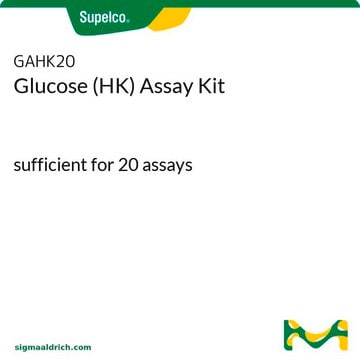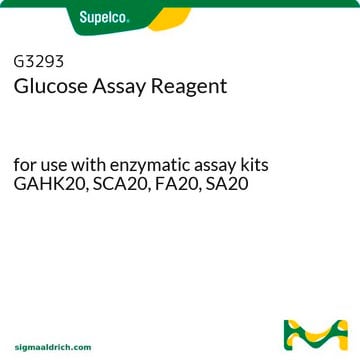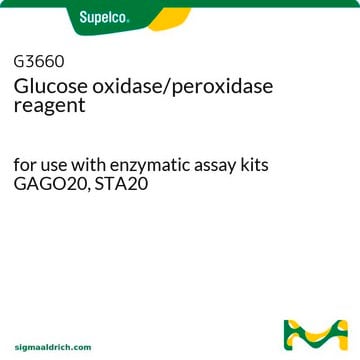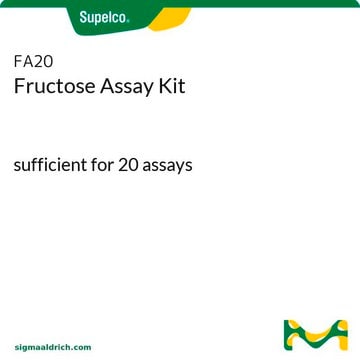Products may be shipped at a different temperature than the recommended long-term storage temperature. If the product quality is sensitive to short-term exposure to conditions other than the recommended long-term storage, it will be shipped on wet or dry-ice. If the product quality is NOT affected by short-term exposure to conditions other than the recommended long-term storage, it will be shipped at ambient temperature. As shipping routes are configured for minimum transit times, shipping at ambient temperature helps control shipping costs for our customers. For more information, please refer to the Storage and Transport Conditions document: https://www.sigmaaldrich.com/deepweb/assets/sigmaaldrich/marketing/global/documents/316/622/storage-transport-conditions-mk.pdf
Wichtige Dokumente
GAGO20
Glukose(GO)-Testkit
sufficient for 20 assays
Synonym(e):
Glucose-Quantifizierungskit
Größe auswählen
Größe auswählen
About This Item
Empfohlene Produkte
Verwendung
sufficient for 20 assays
Qualitätsniveau
Anwendung(en)
food and beverages
general analytical
Lagertemp.
2-8°C
Anwendung
Eignung
Nur Kit-Komponenten
- o-dianisidine reagent 1 mL/vial
- glucose oxidase/peroxidase reagent 1 capsule
- glucose standard .5 mL
Ähnliches Produkt
Signalwort
Danger
H-Sätze
Gefahreneinstufungen
Acute Tox. 4 Oral - Carc. 1B - Eye Dam. 1 - Skin Corr. 1
Lagerklassenschlüssel
6.1C - Combustible acute toxic Cat.3 / toxic compounds or compounds which causing chronic effects
WGK
WGK 3
Hier finden Sie alle aktuellen Versionen:
Analysenzertifikate (COA)
Die passende Version wird nicht angezeigt?
Wenn Sie eine bestimmte Version benötigen, können Sie anhand der Lot- oder Chargennummer nach einem spezifischen Zertifikat suchen.
Besitzen Sie dieses Produkt bereits?
In der Dokumentenbibliothek finden Sie die Dokumentation zu den Produkten, die Sie kürzlich erworben haben.
Kunden haben sich ebenfalls angesehen
-
How is shipping temperature determined? And how is it related to the product storage temperature?
1 answer-
Helpful?
-
-
How can I determine the shelf life / expiration / retest date of this product?
1 answer-
If this product has an expiration or retest date, it will be shown on the Certificate of Analysis (COA, CofA). If there is no retest or expiration date listed on the product's COA, we do not have suitable stability data to determine a shelf life. For these products, the only date on the COA will be the release date; a retest, expiration, or use-by-date will not be displayed.
For all products, we recommend handling per defined conditions as printed in our product literature and website product descriptions. We recommend that products should be routinely inspected by customers to ensure they perform as expected.
For products without retest or expiration dates, our standard warranty of 1 year from the date of shipment is applicable.
For more information, please refer to the Product Dating Information document: https://www.sigmaaldrich.com/deepweb/assets/sigmaaldrich/marketing/global/documents/449/386/product-dating-information-mk.pdfHelpful?
-
-
Why would liquid samples need to be diluted to 20-80 ug/mL? I'm hoping to be able to use this kit to measure glucose levels in serum that should be between 5 - 30 mmol/L. Would this work?
1 answer-
Unfortunately, no, this kit is not suitable for concentrations of 5-30 mmol/L, which equates to 900-5400 mg/L. This concentration is far above the detection range and would offer poor results. The detection range of this kit is approximately 10-100 ug/ml and sample dilution is required for accurate, repeatable results. Measuring samples outside of this range is not recommended.
Helpful?
-
-
Can I use this kit for colorimetric tests?
1 answer-
Yes, this kit is suitable for use with any colorimeter capable of measuring absorbance at 540 nm. Please see the link below to review the product datasheet:
https://www.sigmaaldrich.com/deepweb/assets/sigmaaldrich/product/documents/516/298/gago20bul.pdfHelpful?
-
-
Is it possible to adapt the GAGO20 Glucose (GO) Assay Kit to a 96-well plate?
1 answer-
Researchers have documented an adaptation of the kit to a 96-well assay format as follows.
To prepare glucose standards, 16 µl of 1 mg/ml glucose should be diluted with 84 µl PBS to achieve a 100 µl final volume for a 0.16 mg/ml standard. Four 2-fold serial dilutions into PBS (50 µl 0.16 mg/ml + 50 µl PBS for 0.08 mg/ml standard, etc.) should be done to generate 0.01, 0.02, 0.04, 0.08, and 0.16 mg/ml glucose standards. These assays are linear from 0.01 to 0.16 mg/ml glucose. Glucose stock solutions can be stored at −20°C or 4°C.
Then, 30 µl of glucose standards and a PBS blank should be added to the first row of a clear-bottom 96 well plate. In the next row, 30 µl of each sample should be added into an individual well after diluting them 1:4–1:8 with PBS.For Glucose Oxidase-based Glucose assay:
• Add 100 µl of GO reagent (Sigma; GAGO-20) to each well with a multichannel pipette.
• Seal the wells with parafilm to prevent evaporation and incubate the plate at 37°C for 30–60 min.
• Stop the reaction by adding 100 µl of 12 N H2SO4 (the samples should visibly change color from yellow/orange to pink).
• Centrifuge the plate in an appropriate swing-bucket rotor to clear condensate from the sides of the wells and to remove any air bubbles present in the samples.
• Use a plate reader to measure absorbance at 540 nm.
• Determine the free glucose concentration by comparing the free glucose measurements for each sample to the glucose standard curve.Helpful?
-
-
Can I scale down the reaction volumes 20-25 times lower than what is specified in the protocol? So instead of using 1ml of sample, 2 ml of assay reagent, and 2ml of sulfuric acid, use 50ul, 100ul and 100ul of each step and react?
1 answer-
This kit has been optimized for use at the volumes given in the protocol. The suitability of using smaller volumes in a tube format would have to be determined by the end user and is not recommended. However, other researchers have published an adaptation of the kit to a 96-well assay format which utilizes similar volumes. Please note that this process has not been validated. The 96-well plate protocol can be reviewed below.
Prepare glucose standards: Dilute 16 µl of 1 mg/ml glucose with 84 µl PBS (100 µl final volume) for 0.16 mg/ml standard. Do four 2-fold serial dilutions into PBS (50 µl 0.16 mg/ml + 50 µl PBS for 0.08 mg/ml standard, etc.) to generate 0.01, 0.02, 0.04, 0.08, and 0.16 mg/ml glucose standards. These assays are linear from 0.01 to 0.16 mg/ml glucose. Glucose stock solutions can be stored at −20°C or 4°C.
Add 30 µl of glucose standards and a PBS blank to the first row of a clear-bottom 96 well plate. In the next row, add 30 µl of each sample into an individual well (after diluting them 1:4–1:8 with PBS).
9a)For Glucose Oxidase-based Glucose assay:
Add 100 µl of GO reagent (Sigma; GAGO-20) to each well with a multichannel pipette. Seal the wells with parafilm to prevent evaporation and incubate the plate at 37°C for 30–60 min. Stop the reaction by adding 100 µl of 12 N H2SO4 (the samples should visibly change color from yellow/orange to pink). Centrifuge the plate in an appropriate swing-bucket rotor to clear condensate from the sides of the wells and to remove any air bubbles present in the samples. Use a plate reader to measure absorbance at 540 nm. Determine the free glucose concentration by comparing the free glucose measurements for each sample to the glucose standard curve.Please see this article for more information: https://www.ncbi.nlm.nih.gov/pmc/articles/PMC4048761/
Helpful?
-
-
Can I perform the reaction on polystyrene based plastic tube? ie do the reaction directly on 96-well clear plate
1 answer-
Researchers have published an adaptation of the kit to a 96-well assay format as follows. Please note that this process has not been validated.
Prepare glucose standards: Dilute 16 µl of 1 mg/ml glucose with 84 µl PBS (100 µl final volume) for 0.16 mg/ml standard. Do four 2-fold serial dilutions into PBS (50 µl 0.16 mg/ml + 50 µl PBS for 0.08 mg/ml standard, etc.) to generate 0.01, 0.02, 0.04, 0.08, and 0.16 mg/ml glucose standards. These assays are linear from 0.01 to 0.16 mg/ml glucose. Glucose stock solutions can be stored at −20°C or 4°C.
Add 30 µl of glucose standards and a PBS blank to the first row of a clear-bottom 96 well plate. In the next row, add 30 µl of each sample into an individual well (after diluting them 1:4–1:8 with PBS).
9a)For Glucose Oxidase-based Glucose assay:
Add 100 µl of GO reagent (Sigma; GAGO-20) to each well with a multichannel pipette. Seal the wells with parafilm to prevent evaporation and incubate the plate at 37°C for 30–60 min. Stop the reaction by adding 100 µl of 12 N H2SO4 (the samples should visibly change color from yellow/orange to pink). Centrifuge the plate in an appropriate swing-bucket rotor to clear condensate from the sides of the wells and remove any air bubbles present in the samples. Use a plate reader to measure absorbance at 540 nm. Determine the free glucose concentration by comparing the free glucose measurements for each sample to the glucose standard curve.Please see this article for more information: https://www.ncbi.nlm.nih.gov/pmc/articles/PMC4048761/
Helpful?
-
-
How would you deproteinate and decolorize serum sample to be compatible with the GAGO20 assay kit?
1 answer-
There are a number of ways to deproteinize serum. Most classical methods use acids or solvents to precipitate proteins followed by centrifugation. One example is given below:
Use perchloric acid (10% v/v) in a volume equal to the sample, mix well, and centrifuge. Remove the supernatant and neutralize it with KOH (20% w/v). Allow to stand for 10 minutes in an ice bath and centrifuge. The sample (supernatant) can then be run in the assay.Another option is filtration through a 10 kDa MWCO spin filter. The spin filter that can be used for this purpose is SKU UFC5010.
https://www.sigmaaldrich.com/US/en/product/mm/ufc5010Note that high hemoglobin levels (caused by hemolysis upon collection) may also contribute to the colorization of serum and plasma, however upon dilution, it should not be a factor with GAGO20.
See the link below to a publication that reviews other methods of deproteinization:
https://www.longdom.org/open-access/deproteination-of-blood-plasma-in-human-body-for-serum-analysis-93551.htmlHelpful?
-
-
What is the Department of Transportation shipping information for this product?
1 answer-
Transportation information can be found in Section 14 of the product's (M)SDS.To access the shipping information for this material, use the link on the product detail page for the product.
Helpful?
-
-
How would I decolorize my sample for use in the glucose assay using Product GAGO20, Glucose (GO) Assay Kit?
1 answer-
First, you will need to determine if the color affects the result by reading it as a blank in the assay. The classical method for decolorization of carbohydrate solutions is treatment with charcoal. A small amount of powdered charcoal such as Product C3345 is added to the sample, stirred a few moments, then clarified by filtration or centrifugation. If the color persists, another portion of charcoal is added and the process repeated until there is no more change in color with an addition of charcoal.
Helpful?
-
Active Filters
Unser Team von Wissenschaftlern verfügt über Erfahrung in allen Forschungsbereichen einschließlich Life Science, Materialwissenschaften, chemischer Synthese, Chromatographie, Analytik und vielen mehr..
Setzen Sie sich mit dem technischen Dienst in Verbindung.









